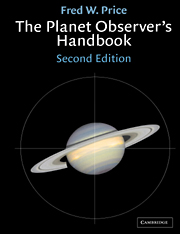Book contents
- Frontmatter
- Contents
- Foreword
- Preface
- Acknowledgements
- Abbreviations used in this book
- Introduction: Why observe the planets?
- 1 The Solar System
- 2 The celestial sphere
- 3 Telescopes and accessories
- 4 The atmosphere and seeing
- 5 Mercury
- 6 Venus
- 7 Mars
- 8 The minor planets (asteroids)
- 9 Jupiter
- 10 Saturn
- 11 Uranus
- 12 Neptune
- 13 Pluto
- 14 Constructing maps and planispheres
- 15 Planetary photography and videography
- 16 Photoelectric photometry of the minor planets, planets and their satellites
- Appendix: Milestones in Solar System exploration
- Name index
- Subject index
13 - Pluto
Published online by Cambridge University Press: 05 August 2012
- Frontmatter
- Contents
- Foreword
- Preface
- Acknowledgements
- Abbreviations used in this book
- Introduction: Why observe the planets?
- 1 The Solar System
- 2 The celestial sphere
- 3 Telescopes and accessories
- 4 The atmosphere and seeing
- 5 Mercury
- 6 Venus
- 7 Mars
- 8 The minor planets (asteroids)
- 9 Jupiter
- 10 Saturn
- 11 Uranus
- 12 Neptune
- 13 Pluto
- 14 Constructing maps and planispheres
- 15 Planetary photography and videography
- 16 Photoelectric photometry of the minor planets, planets and their satellites
- Appendix: Milestones in Solar System exploration
- Name index
- Subject index
Summary
General
Pluto, the outermost planet of the Solar System, has an estimated diameter of 1431 miles (2302 km) and a mass equal to 0.0025 Earth masses. It has an apparent visual magnitude of 13.7. Its axial rotation period is 6 days 9 hours and 17 minutes. The rotational axis is tilted at an angle of 118° to the plane of its orbit. Pluto orbits the sun at an average distance of 3674.48 million miles (5913.52 million km). Its orbital eccentricity of 0.25 is so high that Pluto will be closer to the sun than Neptune between 1979 and 1999. The orbit is inclined at an angle of 17.1° to the plane of the ecliptic. Pluto makes one complete orbital revolution around the sun in 248.54 Earth years and moves with an average speed of 2.95 miles (4.7 km) per second.
Pluto has one satellite, Charon, that revolves around its primary at a distance of 12 204 miles (19 636 km). It makes one revolution around Pluto in the same time that Pluto rotates once on its axis. The minimum diameter given for Charon is 739 miles (1190 km). It has an apparent visual magnitude of 16.8. The plane of the orbit of Charon around the primary is tilted at a large angle (98.8° to the plane of Pluto's orbit. This means that twice in every orbital revolution of Pluto, Charon's orbital plane will be presented edgewise to the Earth and Pluto and Charon will show mutual transit and occultation phenomena.
- Type
- Chapter
- Information
- The Planet Observer's Handbook , pp. 364 - 376Publisher: Cambridge University PressPrint publication year: 2000



